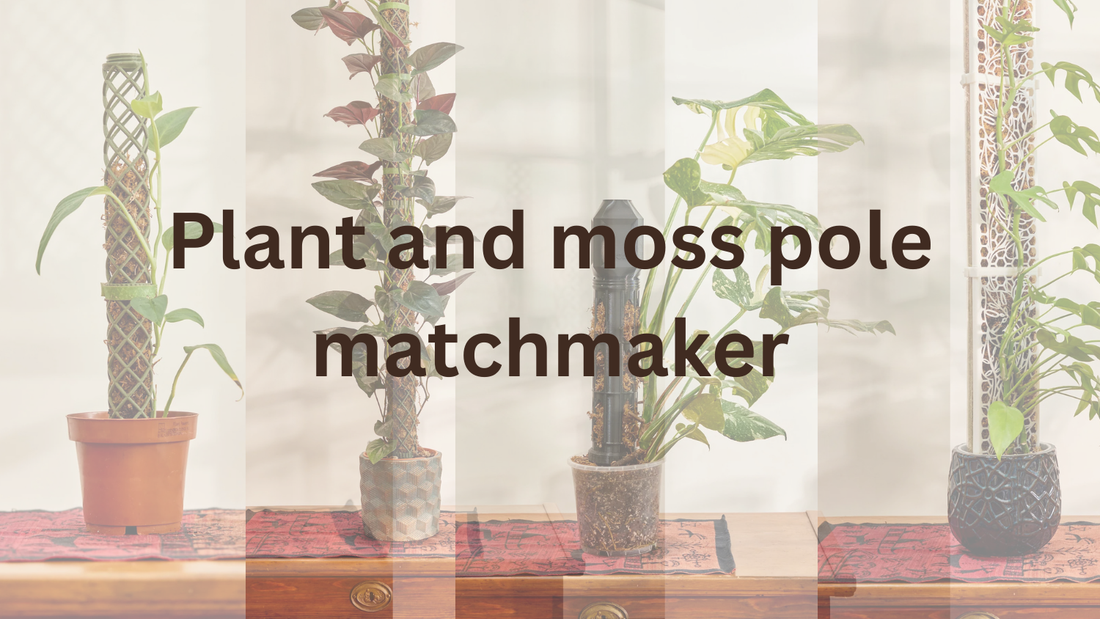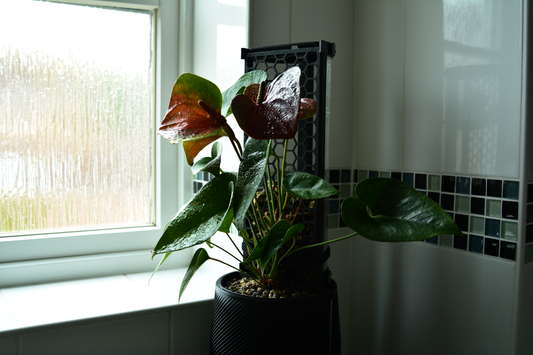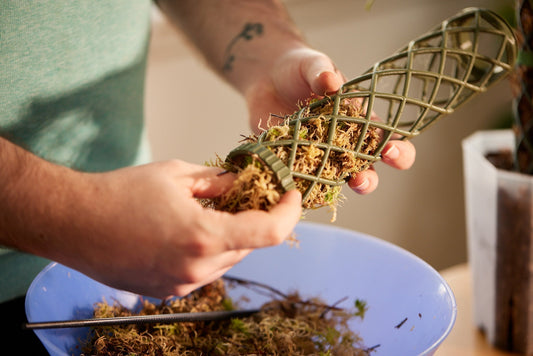
Matching your common houseplants with moss poles
Share
Unsure which moss pole will work with your plant or got a new plant you need to train up a moss pole? Confused about whether you need a wider D-shape or a more traditional cylindrical pole?
We created this guide to help you, and though every plant and situation is different, there are some general moss pole growing guidelines based on size, weight, habitat etc.
Remember, you can always ask us for advice and send us pics and questions about your plants, if you still have doubts after this general pairing guide!
Monsteras and moss poles: match made in heaven

Moss poles and monsteras go together like wine and cheese.
Monsteras are some of the most popular and widely available moss pole plants. We love them because they are so versatile, and you can find Monstera and aroid plants that suits beginners and pros alike. From widely available Monstera Deliciosa, to the rarer Monstera Peru Obliqua, these are great moss pole companions.
Why do Monsteras like moss poles?
Monstera plants climb trees in their rainforest habitats, using aerial roots to attach to the bark. A moss pole helps mimic this environment, encouraging the plant to produce larger, more fenestrated leaves. By providing moisture through the moss to the aerial roots, we try to mirror the effect of rainfall feeding these root systems.

Monstera Deliciosa and its variations (Thai Constellation, Aurea, Albo) prefer sturdy poles
Large diameter sturdy poles such as the XXL and the Turra (our Thai is seen below on its Turra) are perfect for this sturdy Monstera type. The stems of these large form plants can grow very thick and strong, and will pull a smaller pole to bits! The aerial root systems can also grow quite huge, so the additional volume to grow those roots into is a plus.

Monstera Adansonii and its variations (Mint, Albo)

These fast growers can reach incredible heights, so choose an XL or D-Shaped Pole to give them room to grow. Our Adansonii pictured above has loved its XL pole (our most cost-effective option as well), here seen on our Flutes planter (where the moss pole is securely and directly attached to the base planter). This helps provide a bit of extra stability.
A great moss pole Monstera, the Adansonii is relatively easy to get impressive results with.
Monstera Minima likes the Barbara
Our Monstera Minima is seen below on the Barbara, a variation of the D-shaped line. It's a good trade-off when it comes to aesthetics and sturdiness.

The Barbara is perfect as a Monstera trellis, and its pattern is actually inspired by the Monstera!

Can you spot the Monstera leaf pattern in this close-up?
Monstera Dubia, Peru, Standelyana: smaller Monsteras
You can create beautiful green walls with a single faced pole like the D-Shaped Pole that works well with these lighter, thinner stemmed Monstera types. The greater moss volume, paired with the semi-covered back, means you will have an environment that stays moist for much longer than the standard cylindrical poles.
Our Dubia is a long-standing D-shaped moss pole match made in heaven, and it has given us some massive leaves and growth.
Recently, we chopped it down and have been training it up a D-pole with a soilless base, which can be seen pictured below.

We highly recommend the Monstera Dubia as a moss pole plant, we have seen some great results.
These Monstera types will also work well on our standard XL poles.

- Choose a sturdy moss pole, as Monsteras can have thick heavy stems.
- They also put out some pretty massive aerial roots (one might even say they're Monstrous), so you'll need a large diameter pole to contain them.
- You can also use moss poles on smaller Monstera types.
Moss pole Monstera training tips here for anyone looking for more hands-on details!

Monstera Peru on a lab test pole
Philodendrons can also make moss pole magic

Many Philodendron species are climbers and appreciate the support of a moss pole. They use their aerial roots to grip onto the pole, which can encourage larger leaf growth. Some Philodendrons can grow very tall, so consider an extendable moss pole that you can secure to a wall.
Not every Philo needs or benefits from a moss pole: Birkin and other smaller Philos might not make such moss pole magic, and we also let our Philodendron Micans trail, though it can also be trained up a moss pole.
Their aerial roots tend to be much slimmer and weaker than those of a Monstera, and thus will need additional encouragement to grip onto a pole.
Pro tip: wrap the nodes with a little extra moss, and pin them against the pole with some cling film, locking in the moisture, and ensuring aerial growth and connection!
Imperial Green, Red Congo, Black Cardinal need a sturdy base
These large Philodendron don't "need" a moss pole as such, as they tend to be lower and bushier than some of their sisters, but a moss pole can act as an aesthetic growing aid, helping the stem stay upright, and helping the plant mature with the extra growing medium of the moss.
Large diameter sturdy poles such as the XXL and the Turra are best for these sturdy and impressive Philos, as the roots and leaves become heavy. Below is our Philo Rojo Congo (Red Congo) on our white Turra.

Melanochrysum is a moss pole winner

This is a fantastic moss pole plant and has given me epic results on an XL (Honeycomb Yellow pictured), so much so that we had to use some brackets to secure it after it had grown past a certain point (XL moss pole bracket helps secure these slimmer poles to the wall). This is another really satisfying moss pole plant, with big beautiful velvety leaves!
Majestic, Glorious, Rojo, Paraiso Verde, pair with XXL
Large diameter sturdy poles such as the XXL are best as these majestic Philos can quickly reach over 2 m (6 feet) in height.
These are satisfying to grow on moss poles as they give out such great leaves and you can really see the root growth.

Pothos (Epipremnum aureum) can also be trained to climb

While often grown as trailing plants and maybe not the most satisfying moss pole plant, Pothos can also climb and will attach to a moss pole using its aerial roots. This can encourage the plant to produce bigger leaves. A standard coir pole is usually sufficient for Pothos, but ensure it's inserted securely in the pot.
In terms of a moss pole pairing an XL pole is usually sufficient to encourage growth.
Syngonium (Arrowhead Plant)
Many Syngoniums are natural climbers and will use a moss pole to support their growth upwards, which can result in a fuller and taller plant. They don't usually require a very tall pole, but the pole should be moist to help the aerial roots attach.

An XL pole is usually sturdy enough as syngoniums are not very heavy. Our Syngonium Red Arrow has taken well to its XL moss pole in olive green (pictured above) and has been giving us consistently bigger leaves.

Mojito, another excellent climber.
We also have a Pink Confetti Syngonium which is not a huge climber, and for that we just use a simple trellis.
Hoyas might not be the best moss pole match
Some climbing Hoya species can benefit from a moss pole, if used to support their twining growth habit and potentially encouraging longer vine growth. However, hoyas don't seem to embed into moist moss, so maybe a trellis or other stake or support might be more appropriate?
Hoyas prefer not to have constantly wet roots or bases, so ensure the moss pole does not overly increase the pot's moisture level for these plants.
Climbing Ficus
Ficus plants, especially the climbing/shrubby varieties, can attach to and climb up moss poles, mimicking their natural tendency to climb trees. These plants might require a sturdier pole, especially as they grow larger and heavier.
A flat faced pole such as the D-Shaped Pole will develop into a fully green wall.
L-Line moss poles are great for nursery plants
Our smaller L-line moss poles work across the plant kingdom, but they are best matched with smaller and growing nursery plants.

They can be used to encourage cuttings to take root and to train young plants to grow upright.

General tips for matching moss poles
Moisture levels
Consider the moisture preference of the plant. Moss poles are great for plants that thrive in high humidity but might not be suitable for plants that prefer dry conditions. (Think Monsteras vs Hoyas).
Climbing vs trailing
The plant's growth habit (climbing vs. trailing) can dictate the need for a moss pole and the type that's best suited to it. Some plants can both vine and trail, but there tends to be natural preference for one or the other.
Aesthetics
Some people choose moss poles based on aesthetic preferences, aiming to match the look of the pole with the plant and the surrounding decor.
Not always going to be 100%
Sometimes plants can be fickle and they can get unhappy with their environment. Testing things with different placements, soil mixes, and moss poles can help you determine what's best for your plant. Things might also change and evolve, and you may see a previously happy plant start to throw hands.
Getting the right moss pole for your plant is about trial and error as much as it is about aesthetics and getting "the perfect match". Having said that, there are some fail-safe pairings here that are known to get results. A lot depends on your plant care consistency and your goals.



